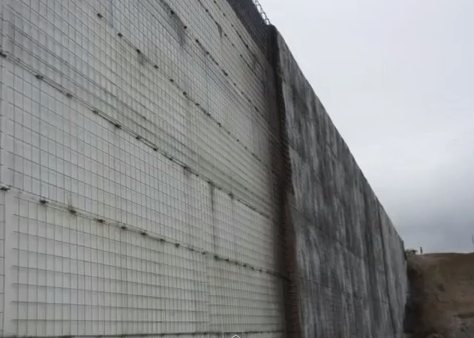McCammon, Idaho’s heavily used trucking route and bridge (circa 1940) along the U.S. 30 trucking route between Idaho and Wyoming, expands from 2 to 4 lanes to increase safety and capacity using InsulFoam GF – Geofoam.

Geofoam blocks were used to construct a new 500 foot long, 30 foot tall EPS block embankment. The new embankment supports the US-30 road expansion and its approach to the new Topaz Bridge – notably the longest span in the state of Idaho.
Project Overview:
Idaho Transportation Department’s first EPS Geofoam project was designed by Terracon Engineers and JUB Engineers of Boise. EPS was specified as a soil replacing embankment fill material due to poor foundation soils and 2 steel fish culverts that could not bear the weight of traditional soil fill. A new three-span bridge replaced the existing bridge (from the 1940’s) crossing rail road tracks, the Pontneuf River and expanding the highway to 4 instead of 2 lanes. In all, 23,000 cubic yards of large block EPS was installed by Scarsella Brothers Inc. and supplied by Insulfoam.
The Problem:
The expansion of US-30 and bridge replacement required a new fill embankment to support the new roadway and bridge approach on a very steep side slope.
The new (500 ft long) expanded bridge clears The Pontneuf River as well as the Union Pacific Railroad tracks, and required a new higher grade of both thte bridge structure and the existing roadway to support the new wide and long center spans.
As a result the new bridge approach embankment would be 45-50 feet high, too costly to be retained by conventional concrete cantilever or MSE wall, and raised concerns about global stability.

Near “Net-Zero” surcharge loads: The void in between the blocks and the native slope was filled with sand.
Further challenges to the projects design were the site conditions. Located adjacent to the Pontneuf River, shallow bedrock and loose or soft sediments under lie the new approach embankment.
The EPS Geofoam Fill Solution:

To reach the new bridge’s approach embankment height of 45 feet, engineers chose a combined fill solution. The lowest 15 feet was a small earthen embankment, while InsulFoam GF constituted the upper 30 feet. 4 1/2 feet of granular fill retained in wire gabions and an asphalt pavement section were installed directly on top o the EPS blocks to complete the full height of the new embankment.

The exposed vertical face of the EPS is eventually covered with an economical, fast to install, protective shotcrete facing.
The soft sediments underlying the site required the lower earthen embankment to settle (80 days), but the InsulFoam GF block fill required no additional surcharge time or secondary compaction by the contractor. Traffic moved on the existing roadway throughout the installation of the upper embankment, which was a key factor for the expansion to finish when weather conditions permitted.
The ultra lightweight nature of EPS allowed the total design weight of the tall embankment to be well under the bearing capacity of the poor foundation soils which aided ITD in successfully completing their first EPS Geofoam project.
For more information about Geofoam visit www.insulfoam.com




